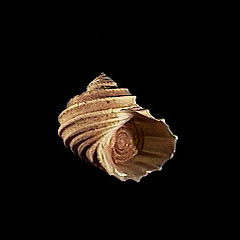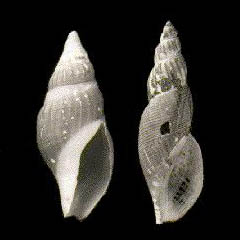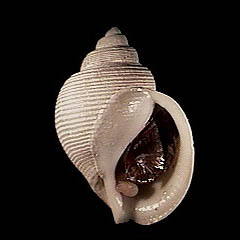Deep-Sea Mollusks -- An Introduction
by José H. Leal
Mollusks from many different groups live in the deep sea. Our shell-makers can be found at all depth levels of the ocean bottom; no limit is known on the depths at which they can live. Mollusks have been found in the deepest point of all oceans, the Challenger Deep in the Marianas Trench, at 11,022 m (about 36,000 feet) depth. This section examines a group of animals that share the ability to live in an environment with conditions quite different from the conditions of shallow water, and yet are related and relatively similar to their shallow-water counterparts. Factors such as temperature, pressure, amount of available light and types of food change rather uniformly as we move into deeper water; we can expect that mollusks living at the same depths but in different parts of the world's oceans will conform to these conditions in a somehow similar fashion. This section also includes some faunas from exceptional habitats such as deep-sea hot springs (hydrothermal vents) and submarine trenches.
Characterization and zonation of the deep sea
But, first of all, what is "deep sea"? Questions often arise when someone starts to collect shells that cannot be found on the beach or by snorkeling. Where do we draw the line between shallow-water and deep-water habitats? Is your favorite volute a "shallow" species or a "deep" species? Although we use these expressions very often in shell collecting, malacology, and other natural history contexts, there is not a well-established, all-purpose boundary separating "shallow" from "deep." The terms are usually used in comparative situations. For instance, for someone who normally collects shells on the beach or at low tide, deep-sea specimens may be those that are not easily collected on the shoreline or on exposed sand flats. For them, deep-sea species may be rarer species that require more sophisticated collecting methods, including snorkeling, SCUBA, or dredging. Scientists may use the term "shallow water" to loosely indicate species living on the continental shelf bottom. The shelf is that area of the ocean bottom which is simply a submarine continuation of the adjacent continent, from the shoreline to depths between 150 and 300 meters. This shallow-water area is further divided into "littoral" and "sublittoral." Marine biologists use the term "sublittoral species" for organisms living on the continental shelf; "littoral species" are those living between the highest and lowest tide marks in a particular area.
For marine biologists, true "deep-sea" species only appear below the lower depth limit of the continental shelf, also known as the continental break. The continental break marks the end of submerged parts of continents. The break is followed by the continental slope, a rather steep region that extends down from about 1,000 to 2,000 m, depending on the part of the world where it is found. The fauna present on the continental slope is known as the bathyal fauna. The overall molluscan diversity (number of species) in the bathyal region is relatively high.
The continental slope gently gives way to the abyss. The abyssal region, extending from about 1,000-2,000 m to 5,500-6,000 m, constitutes by far the largest area of the seafloor: the average depth of all the oceans is about 3,800 m. (Submarine trenches usually develop downward from depths around 6,000 m, the beginning of the hadal region, exclusive domain of highly specialized and exquisite molluscan communities. Deep-sea mollusks are here defined as those living in the bathyal, abyssal, and hadal regions.
The deep-sea environment
Generally speaking, deep-sea environments differ from those in shallow water by low temperatures, extremely short range of temperature change with increase in depth, increased hydrostatic pressure, predominance of soft bottoms, and the absence of light. The global ocean circulation works in such a way that ocean water that becomes cold at the poles slowly sinks to the bottom of the ocean basins, because cold water is denser. Therefore, ocean water is always colder at the bottom. Temperature in the deep sea fluctuates between 4 and -1° C (39 and 30° F); exceptions are the deep waters of the Mediterranean Sea, with temperatures around 13° C (55° F), and the Red Sea, with temperatures around 21° C (70° F) at 2,000 m depth. The deep water in the vicinities of the very hot hydrothermal vents also represents an exception (see below).
Hydrostatic pressure increases steadily as we move down the water column: pressure increases by 1 atmosphere for each 10 m of depth. These huge pressures in the deep sea inevitably affect the metabolic rates of mollusks and other animals living there (metabolic rates in deep sea mollusks usually differ from those in shallow water mollusks) but, contrary to common belief, mollusks brought from the deep sea to the surface will not explode. This could only happen to animals with tightly closed internal spaces filled with water or gases, such as the swimbladder of fishes. Mollusks lack those completely enclosed spaces, and only their metabolic rates are affected by decreased atmospheric pressure when they are hauled from the deep bottom to the surface.
The predominance of soft bottoms in the deep sea is caused by long-term accumulation of sediments, both from continents (clay), and from biological oceanic sources (microscopic skeletons of planktonic organisms such as diatoms and foraminifers). These different kinds of muds make the deep-sea environment extremely favorable to colonization by bivalves and scaphopods (tusk-shells).
Absence of light (light completely disappears at around 1000 m depth) indirectly affects the kinds of mollusks we find in the deep sea: plants require light to grow, and it seems obvious that no plant-eating mollusks will be found at depths where plants are absent. Most mollusks that have adapted to grazing on seaweeds, browsing on the thin cover of microscopic algae present on rocky bottoms, or filtering plankton from the water column will not be found at depths where plants cannot live. Many important herbivore families present in shallow water, such as Strombidae, Crepidulidae, Patellidae, Fissurellidae, Haliotidae, among the gastropods, and the Cardiidae, Veneridae, Mytilidae, etc., among the bivalves, are poorly represented or absent in the deep sea, particularly in the abyssal and hadal regions.
The feeding habits of deep-sea mollusks
Four basic kinds of food available define the four major types of feeding habits of deep-sea mollusks: scavenging, deposit-feeding, predation and parasitism. The numbers of species of scavengers (mollusks feeding on carcasses of larger organisms such as fish, bones, etc.) and of deposit-feeders (feeding on the "snow" of particles falling from the water layers above to be deposited on the sea bottom) are higher at greater depths when compared to shallow water. Scavengers are represented in the deep sea by a number of families in the order Cocculiniformia, including the Bathysciiadidae (feeding on sunken cephalopod beaks), Osteopeltidae (whale and fish bones), Lepetellidae (tubes of polychaete worms), and Choristellidae (empty egg-cases of sharks and rays). Also, some species of Buccinidae, and possibly some of the Volutidae, are scavengers. "Herbivore" mollusks in the deep sea are restricted to species that feed on sunken dead plant material, such as the trochid Cataegis finkli (Petuch, 1987), which feeds on seagrass blades, and cocculiniform limpets of the families Cocculinidae and Pseudococculinidae, which feed on a wide variety of sunken plant remains and act as plant decomposers (possibly with help of symbiotic bacteria that help them digest cellulose, the hard component in wood and plant tissue). (See also trench fauna.) In the deep-sea floor, especially at abyssal depths, most of the food available to animals is in the form of detritus, either carcasses of larger organisms such as fish that die in midwater, or fine submarine "snow," usually the remains of planktonic organisms that fall from water layers above and accumulate on the bottom. Many of the deposit feeders are archaeogastropods such as the trochids Bathybembix, and Gaza, and protobranch bivalves belonging to the families Nuculidae and Nuculanidae. Unlike most shallow-water bivalves in the order Eulamellibranchia, protobranchs do not rely heavily on their gills to filter-feed particles suspended in the water. Instead, they sweep the bottom surface with a pair of tentacle-like structures, feeding on food particles that fall from the water layers above. Predators such as turrids, volutids, naticids, and oocorythids are also abundant and widely diversified. Turrids feed on a myriad of worms living in the muddy bottoms, paralyzing their prey by injecting venom through modified arrow-like radular teeth quite similar to those of their close relatives, the cone shells. Surprisingly enough, a group of deep-sea clams of the Order Septibranchia (e.g., families Cuspidariidae, Poromyidae, Verticordiidae) are carnivores. The gill filaments in this group are modified into septa that explosively pump water in, sucking into the mantle cavity small crustaceans such as copepods and amphipods . In some extreme cases, verticordiid bivalves have sticky tentacles around the inhalant aperture to help them catch their prey.
Parasitism involves the invasion of an animal's body by another animal that has become highly specialized to live and feed on the host without killing it. Until recently, not much importance was attached to deep-sea parasitic mollusks. That is quickly changing with the realization that diversity runs high in the Eulimidae, a family of small snails that are parasitic in a wide variety of echinoderms. Some species are permanently attached to the hosts, feeding on their fluids by mean of a long tube-like prosboscis.




Trochidae
Cataegis finkli (Petuch, 1987)
UMML 30.3576, off Colombia, 1171-1239 m; height = 19 mm [paratypes of C. toreuta McLean & Quinn, 1987.] photo, Ross Gundersen
Turridae
Gymnobela chyta (Watson, 1881)
Tongue of the Ocean, UMML 30.9736, Bahamas, 1320 m depth; length = 38 mm photo, Ross Gundersen
Volutidae
Left: Miomelon philippianum (Dall, 1890), USNM 97128, holotype, off Chile, 1240 m depth; length = 36 mm.
Right: Tractolira sparta(Dall, 1896), USNM 122999, holotype, from off Gulf of Panama, 3060 m depth; length = 60 mm. Photos, Victor Krantz
Oocorythidae
Oocorys umbilicata Quinn, 1980
Tongue of the Ocean, UMML 30.9737, Bahamas, 1320 m depth; length = 42 mm photo, Ross Gundersen
Trench mollusks

Left: Cocculinidae, new genus new species Puerto Rico Trench, 8,595 m; length = 3.8 mm; photo, M.G. Harasewych Right: Pseudococculinidae, Caymanabyssia spina Moskalev, 1976 UMML 30.8393, Cayman Trench, 7,225 m; length = 2.5 mm; photo, J.H. Leal
Highly specialized cocculinid and pseudococculinid limpets are important components of the faunas of submarine trenches, also known as the hadal fauna. Trenches represent the deepest parts of the oceans, and are frequently the result of collision of the gigantic plates that make up the surface of our planet. The same geological mechanism that makes trenches is responsible for the formation of the volcanic islands which are often associated with them. The Marianas, Tonga, the Philippines, the Aleutians and the South Sandwich islands are a few examples. Because of the geographic proximity of trenches to islands, a huge amount of plant material gets carried down to a trench floor during tropical storms, hurricanes, and typhoons. This plant material is used both as substrate and food by a number of marine invertebrates, including cocculiniform limpets and xilophagaid clams. These latter are effective deep-sea wood-borers. Sunken plant material includes mangrove seedlings, wood, seagrass blades, fruits and seeds of rainforest trees, and a vast amount of leaves. Different genera of cocculinid and pseudococculinid limpets specialize in feeding upon these different resources. Here we have a situation which represents a kind of "short circuit" in the classic ecological models for deep-sea food webs. Most descriptions of deep-sea food webs involve a large number of feeding levels based on the large physical distance separating primary producers (plants, absent in the deep sea) from predators and scavengers, and the absence of herbivore mollusks such as keyhole and true limpets, and true filter-feeding bivalves, such as venerid, cardiid, and other clams.
Mollusks from hydrothermal vents Hydrothermal vents (HTVs) occur in parts of the deep sea where volcanic activity is intense. In spite of harsh environmental conditions, HTVs are surrounded by veritable oases of marine life, with 10,000 to 100,000 times more living matter than normal deep-sea bottom communities. Here, water penetrates holes and fissures in the recently solidified ocean bottom and escapes again through the vents at very high temperatures (in many cases up to 400° C). This water carries with it a lot of minerals, including heavy metals and sulfur in its hydrogen sulfide form. Hydrogen sulfide is a key player in the HTV ecosystem, just as sunlight is on and near the surface. The oxidation of hydrogen sulfide to sulfate, a different sulfur compound, provides bacteria living around the vents with the energy necessary to produce organic matter, pretty much in the same way as the sun provides plants with the energy to perform photosynthesis and grow. The sulfide-oxidizing bacteria are, in their turn, the source of food for many of the HTV animals, which include the giant clam Calyptogena magnifica, the giant mussel Bathymodiolus thermophilus, and several bacteria-eating gastropods. These mollusks lack mouth and guts and, like land animals, have red hemoglobin in their blood to transport oxygen to different parts of their bodies.
Hydrothermal vents are considered one of the probable environments for the evolution of life on our planet, but the mollusks that are found there are closely related to forms living in other deep-sea and shallow-water areas. Recent studies have shown that new vents can be colonized quickly by mollusk larvae transported by deep currents from other vent sites. After the discovery of HTVs in 1977, a relatively large number of groups of mollusks living almost exclusively around HTVs has been described. These include the limpet-related families Clypeosectidae, Cyathermiidae, Neomphalidae, Peltospiridae, Pyropeltidae, and Lepetodrillidae, all named and described by Jim McLean of the Los Angeles County Natural History Museum.
José H. Leal, Ph.D., Director, The Bailey-Matthews Shell Museum, P.O. Box 1580, Sanibel Island, FL 33957
Abbreviations used with the graphics:
UMML = Marine Invertebrate Museum, Rosenstiel School of Marine and Atmospheric Science, University of Miami; UNSM = National Museum of Natural History, Smithsonian Institution. Conversion from meters to feet: one meter = 3.28 feet.
See also:
"How Deep is Deep? Museum Hunting for the Deepest Atlantic Mollusks" by Dr. Leal (from American Conchologist, December 1996)
Additional link:
The DEEPSEA Research Newsgroup (report new link)

Calyptogena magnifica Boss & Turner, 1980
Giant Vent Clams
DSRV Alvin Dive 1214-3A
East Pacific Rise 21°N; 2600 m depth
© Woods Hole Oceanographic Institution


